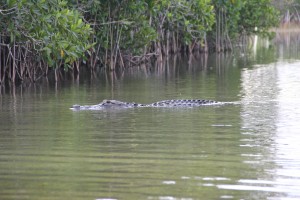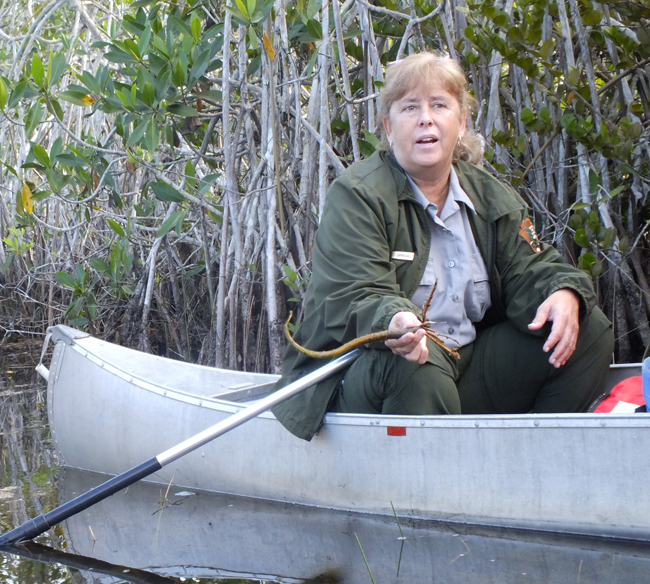Paddling In The Everglades Can Be A Journey Back To Another Time
by Zarrin Ahmed
Christie Carmichael, dipped her paddle and rowed gently along Nine Mile Pond in Everglades National Park. The park ranger’s eyes scanned everything while she led visitors in the trailing canoes; nothing was going to get past her radar.
“Gator to the left, folks!” She alerted the three canoes behind her own. Her voice held ease and confidence, and her message held unspoken yet strict instructions. A quickened hush fell over the group as each person listened closely and looked out sharply. Carmichael did not hesitate or stall, gently and continually moving along.
Earlier, when the canoeists had gathered by the edge of the pond, it was deceivingly quiet.

Photo by Kaitlyn Carroll
At 8 a.m., under blankets of thick gray clouds, darkness swept the area. Yet the sun beat strongly, and at one point it had broken through the barrier. Rays of sunshine poured from the sky and the light stretched across the pond: it was the only reminder and promise that change would soon occur.
The canoe ride followed a trail through a couple of ponds and circled back, a journey that spanned three hours. Carmichael said the water trail would only be about a foot and a half deep.
The four boats and their nine passengers slipped into the waters, gliding slowly through the first big pond. The skies cleared, birds responded with their calls, and lush plants swayed in the breeze around the pond. Everyone quickly became comfortable in their boats, then… something came toward them.
“Oh shoot man, that’s not…” Carmichael said from her boat. “That’s the crocodile.”

Photo by Zarrin Ahmed
Along the left shore of the pond, the crocodile swam toward one of the canoes, barely making a sound. One of the passengers in that same canoe kept trying to attract alligators by splashing his hand in the water. He didn’t expect a crocodile to answer. Everyone looked with wonder and held their breath. Carmichael assured the group that “it doesn’t really have an interest in us” though it did not hesitate to swim a foot away from the canoe. Unlike alligators, when a crocodile swims, most of its spiky back is exposed above the surface of the water and its tail is seen slithering back and forth. The arms and legs of both creatures are kept still on the sides and their black eyes fixated in front of them.
It was an American crocodile measuring about ten feet long. The American crocodile is an endangered species and its northernmost range is southern Florida. Though the Everglades is the only place both alligators and crocodiles exist together, the behavior of this species is very different from alligators and sightings of crocodiles at the pond was rare, Carmichael told the group.
“That is a treat to see. Personally I’d prefer not to see them so close.” During the dry season in the winter, the water levels decrease, forcing alligators and crocodiles into the ponds for shelter. The crocodile moved along, undisturbed, and so did Carmichael.
The caravan traveled on. Turkey vultures showed off their wings while perched on trees and blue herons stalked the edges of the ponds. The group crossed the ponds, arriving quickly at the tangled brush and trunks of red mangrove trees. The trail became very narrow and the canoes formed into a line while turning sharply through the trees.
The mangrove trees forced the canoes and alligators to come into very close contact. Most alligators avoided the caravan by wading in small enclaves that stemmed from the trail. Carmichael banged her paddle against the canoe every so often to “help them know we’re coming.”
Coming to the end of the mangrove trees, an alligator floated along the right side of the trail. Carmichael said the alligator was probably trying to get to a pond but couldn’t avoid the group of canoes. Though each boat maneuvered slowly and carefully around the alligator, it gave warnings of aggression: deep hissing and slapping the water with its head.
The alligator was intimidated. Carmichael explained, “What he wants to do is get out of the way of us.”
The alligator’s intention wasn’t to attack, but to warn the canoes of the breach of space and privacy. Carmichael asked the group to imagine being the alligator and how it would feel to come across a group of boats of the same length and size. She also warned the paddlers to avoid testing their luck.

Photo by Kaitlyn Carroll
“They’re getting a little more feisty, so we wanna try to respect them a little bit. I’d say try to give them as much space as you can,” Carmichael warned. “We’re not here to mess them up; were actually kinda here to leave them alone.”
The time was spring, mating season for the creatures, which means emotions run high amongst alligators and crocodiles. The freshwater habitat of Nine Mile Pond attracts alligators and crocodiles as prime mating territory. Red mangrove trees flourish here, creating tree islands. These tree islands are fertile grounds for the growth of other kinds of trees, which in turn provide nesting areas for birds. The numerous branch-like roots of the mangrove, which extend into a structure larger than that of the tree itself, provide security for fish and nurseries for small crocodiles with its complex tunnels.
Carmichael took the group through one more part of the mangrove trees before reaching open water again, but this time there were no alligators in the trail. They usually go underwater to avoid humans because they are “incredibly shy,” Carmichael says. She was surprised to see any in the trail at all, thinking the ponds were the only place there would be sightings.
“There are no actual lines in the natural world,” Carmichael said. “There are no boundaries that you can cross and define for sure.”
Nine Mile Pond, what Carmichael refers to as a transition zone, is part of the Everglades. The numerous ponds are man made, their fill used to construct roads. These structures have allowed alligators and crocodiles to live in the same waters and thrive alongside each other. The entire pond is home to multiple ecosystems and habitats, which include the freshwater swamp and the red mangroves.
The canoeists returned where they begun three hours earlier. Carmichael had told her visitors that the natural world is complex. It was on this trip that Carmichael had seen more alligators than she had seen all winter. It was apparent that what she said rang true: “it’s a little bit different around here.”